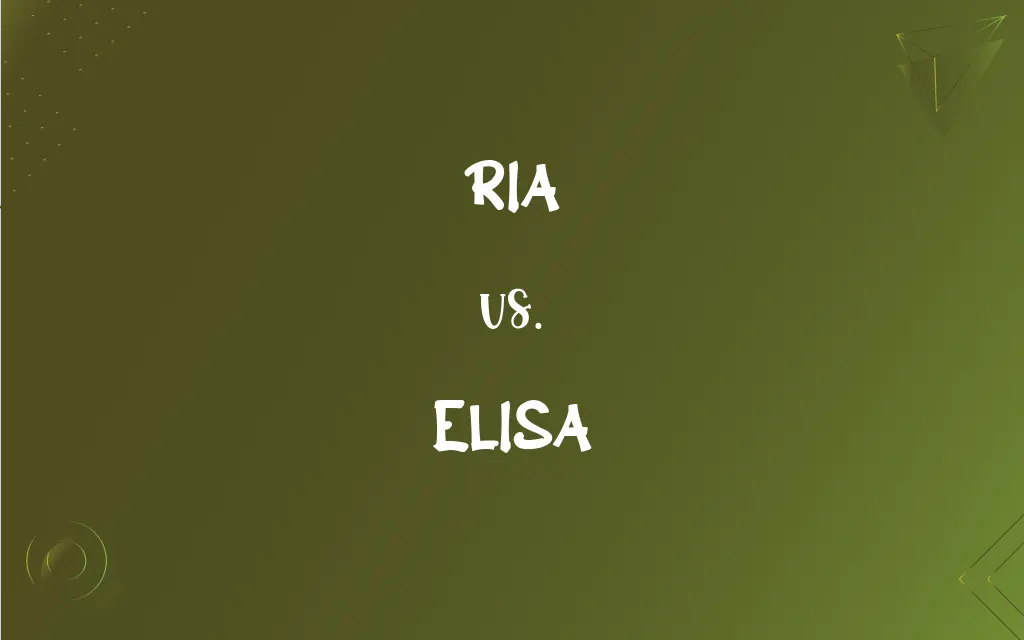RIA vs. ELISA: What's the Difference?
Edited by Aimie Carlson || By Harlon Moss || Published on March 29, 2024
RIA (Radioimmunoassay) uses radioactive isotopes to detect and quantify substances in a sample. ELISA (Enzyme-Linked Immunosorbent Assay) employs enzymes linked to antibodies for detection providing a safer and non-radioactive alternative.

Key Differences
RIA and ELISA are both immunoassays used for the detection and quantification of antigens or antibodies in a sample. RIA, developed in the 1950s, utilizes radioactive isotopes as a marker to signal the presence of a specific substance. It is known for its high sensitivity and specificity but involves handling and disposal of radioactive materials, posing potential health and environmental risks. ELISA, introduced later, uses an enzyme attached to an antibody as the marker. The enzyme, upon reacting with a substrate, produces a measurable product, usually a color change, indicating the presence of the target molecule.
RIA has been pivotal in research and clinical diagnostics for its sensitivity and precision, its use has declined due to the radioactive hazards and the development of safer alternatives like ELISA. ELISA's versatility allows it to be adapted into different formats, such as direct, indirect, sandwich, and competitive, making it suitable for a broad range of applications from disease diagnosis to food safety testing without the risks associated with radioactivity.
The detection limits of RIA can be extremely low, making it ideal for detecting small amounts of hormones, drugs, and other molecules in blood and other fluids. However, ELISA, through advancements in enzyme amplification techniques, has significantly improved its sensitivity, approaching that of RIA for many applications. ELISA's ability to use colorimetric, fluorometric, or chemiluminescent readouts also adds to its adaptability and ease of use in various laboratory settings.
Operational aspects differentiate them further: RIA requires specialized facilities for handling and disposing of radioactive materials, including lead shields and designated waste disposal methods, which can increase operational costs and complexity. ELISA, on the other hand, can be conducted in standard laboratories with common lab equipment, such as microplate readers, making it more accessible and cost-effective for routine use.
In terms of applications, while both assays are used in clinical diagnostics, research, and quality control, ELISA's non-radioactive nature and flexibility have made it the preferred method in many settings, including point-of-care testing and in environments with limited resources. RIA, despite its sensitivity, is now more commonly used in specialized applications where its unique advantages are required.
ADVERTISEMENT
Comparison Chart
Detection Principle
Radioactive isotopes
Enzymes linked to antibodies
Safety
Involves radioactive materials
Non-radioactive, safer for routine use
Sensitivity
Extremely high
High, with advancements closing the gap
Operational Requirements
Specialized facilities for radioactive materials
Standard laboratory equipment
Applications
Hormone, drug detection, specialized research
Broad, including disease diagnosis, food safety
ADVERTISEMENT
RIA and ELISA Definitions
RIA
A sensitive assay using radioactivity to quantify antigens.
RIA was used to measure the thyroid hormone levels accurately.
ELISA
Suitable for colorimetric readouts.
ELISA results can be easily read with a standard microplate reader.
RIA
Known for high precision and sensitivity.
RIA's sensitivity makes it ideal for detecting low-concentration samples.
ELISA
Non-radioactive, enhancing safety.
ELISA's non-radioactive nature makes it preferable for classroom demonstrations.
RIA
Used in specialized applications.
RIA remains indispensable for certain diagnostic tests requiring high sensitivity.
ELISA
Broad applications in diagnostics.
ELISA kits are commonly used for detecting allergens in food samples.
RIA
Requires specialized waste disposal.
The lab disposes of RIA's radioactive waste according to strict regulations.
ELISA
Adaptable to various formats.
The sandwich ELISA format is particularly effective for detecting specific proteins.
RIA
Involves handling radioactive materials.
Special precautions are necessary when conducting RIA due to its use of radioisotopes.
ELISA
Detects antigens using enzyme-linked antibodies.
ELISA is widely used for HIV screening due to its high specificity.
RIA
(geography) A narrow inlet of the sea formed by a flooded unglaciated river valley.
ELISA
A sensitive immunoassay that uses an enzyme linked to an antibody or antigen as a marker for the detection of a specific protein, especially an antigen or antibody. It is often used as a diagnostic test to determine exposure to a particular infectious agent, such as the AIDS virus, by identifying antibodies present in a blood sample.
ELISA
An assay that relies on an enzymatic conversion reaction and is used to detect the presence of specific substances (such as enzymes or viruses or antibodies or bacteria)
FAQs
Can ELISA match the sensitivity of RIA?
With advancements in enzyme technology and amplification methods, ELISA's sensitivity is now comparable to RIA for many applications.
Are there any disadvantages to using ELISA?
While versatile, ELISA may require optimization for specific antigens and antibodies, which can be time-consuming.
Why is ELISA preferred over RIA?
ELISA is preferred due to its safety, ease of use, and versatility, avoiding the need for radioactive material handling.
What type of samples can be analyzed using RIA and ELISA?
Both RIA and ELISA can analyze a variety of samples, including blood, serum, and other bodily fluids, as well as food products and environmental samples.
What happens to the radioactive waste from RIA?
Radioactive waste must be carefully managed and disposed of according to strict regulatory guidelines to prevent environmental contamination.
Is specialized training required for RIA?
Yes, handling radioactive materials for RIA requires specialized training and adherence to safety regulations.
What makes RIA so sensitive?
RIA's sensitivity comes from the high detectability of radioactive isotopes, allowing it to measure very low concentrations of substances.
Can RIA and ELISA be used in tandem for diagnostic purposes?
Yes, RIA and ELISA can be used complementarily in diagnostic workflows, where RIA's sensitivity is crucial for initial screening, and ELISA's versatility and safety are advantageous for broader, more detailed analyses.
How has the development of ELISA impacted clinical diagnostics?
ELISA has revolutionized clinical diagnostics by providing a safe, reliable, and accessible method for detecting a wide range of diseases and conditions.
What role does the choice of enzyme play in ELISA's effectiveness?
The choice of enzyme in ELISA is critical for its sensitivity and specificity. Enzymes that produce highly visible, quantifiable reactions without significant background noise enhance the assay's effectiveness.
What future developments could influence the preference for ELISA or RIA?
Future developments in safer, non-radioactive labeling techniques could renew interest in RIA-like sensitivity without its current drawbacks. Conversely, further improvements in ELISA's sensitivity and automation could solidify its dominance in immunoassay applications.
Can ELISA be automated?
Yes, ELISA can be easily automated, making it suitable for high-throughput screening in laboratories.
How does the regulatory landscape affect the use of RIA and ELISA?
Regulatory considerations, especially regarding the use and disposal of radioactive materials, heavily influence the adoption of RIA. ELISA, being non-radioactive, faces fewer regulatory hurdles, making it more appealing for routine use in various settings.
What are the ethical considerations associated with RIA?
Ethical considerations include the health and safety of laboratory personnel and the environmental impact of radioactive waste, necessitating strict adherence to ethical standards and safety protocols.
What impact does the global push for greener laboratories have on the choice between RIA and ELISA?
The global push for greener, more sustainable laboratory practices favors the adoption of ELISA over RIA, as ELISA does not involve hazardous materials and aligns better with environmental sustainability goals.
How do the costs of RIA and ELISA compare?
Generally, ELISA is more cost-effective due to the absence of expensive radioactive materials and waste disposal requirements.
What are the environmental impacts of using RIA?
The use of RIA involves radioactive materials, which can have significant environmental impacts if not properly managed, including contamination of water and soil and exposure risks to laboratory personnel and the environment.
How do advancements in biotechnology affect ELISA and RIA?
Advancements in biotechnology, especially in the production of highly specific antibodies and sensitive detection technologies, have enhanced ELISA's sensitivity and specificity, making it a more competitive alternative to RIA. For RIA, biotechnological advancements have improved the safety and efficiency of radioactive labeling and detection methods.
How do sample preparation requirements differ between RIA and ELISA?
RIA often requires more complex sample preparation to protect the integrity of the radioactive signal, whereas ELISA can generally handle a broader range of sample types and conditions, making it more flexible and user-friendly.
How does the specificity of antibodies used in ELISA and RIA affect the outcome?
The specificity of antibodies directly affects the accuracy and reliability of both ELISA and RIA. High-specificity antibodies ensure that the assays accurately identify and quantify the target substance, reducing false positives and negatives.
About Author
Written by
Harlon MossHarlon is a seasoned quality moderator and accomplished content writer for Difference Wiki. An alumnus of the prestigious University of California, he earned his degree in Computer Science. Leveraging his academic background, Harlon brings a meticulous and informed perspective to his work, ensuring content accuracy and excellence.
Edited by
Aimie CarlsonAimie Carlson, holding a master's degree in English literature, is a fervent English language enthusiast. She lends her writing talents to Difference Wiki, a prominent website that specializes in comparisons, offering readers insightful analyses that both captivate and inform.































































